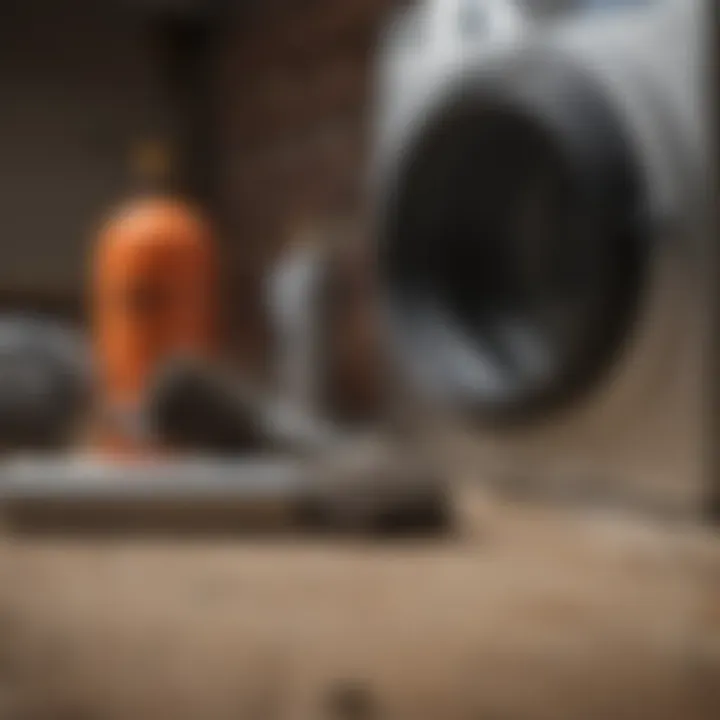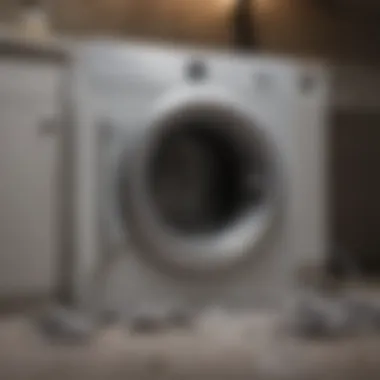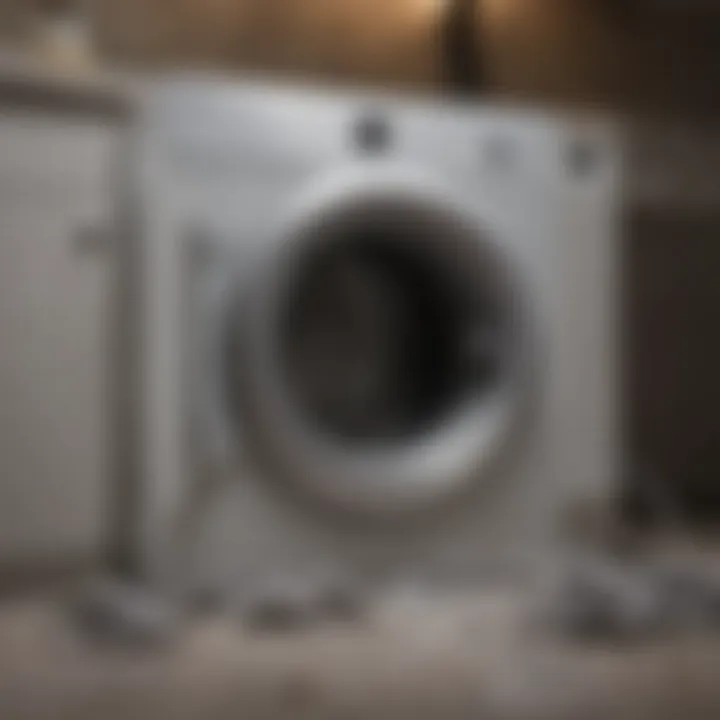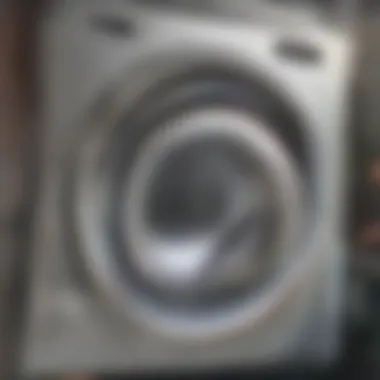Expert Guide to Cleaning Your Dryer Vent Outside


Intro
Cleaning your dryer vent from the outside is not just a matter of housekeeping; it is a critical maintenance task that can significantly impact the performance and safety of your dryer. In the United States, failure to clean dryer vents is a leading cause of fire hazards, resulting in thousands of property damages every year. As homeowners, understanding the process of cleaning this vital component of our laundry systems ensures efficiency and promotes safety.
This guide aims to walk readers through the entire process, from identifying the right tools to conducting the cleaning effectively. It also addresses safety precautions and offers a systematic approach to ensuring that your dryer functions optimally.
Understanding the relevance of this topic is essential. Many homeowners may overlook the importance of regular maintenance, leading to inefficient drying and a considerable risk of fires. By following the steps outlined in this guide, you will be able to maintain your dryer vent and avoid unnecessary hazards.
Featured Homes
When discussing home maintenance, particularly dryer vent cleaning, it's important to recognize that the type of home can play an integral role in the maintenance approach that can be taken.
Architectural Styles
Various architectural styles come with different designs of vent systems. For instance, a traditional single-story home may have straightforward venting systems that are easy to access. However, modern townhouses or multi-story homes can pose unique challenges. In these cases, vent pipes might extend several feet through walls, requiring added attention and possibly professional assistance.
Unique Design Elements
Elements such as vent hood designs will also affect cleaning strategies. Some vent hoods may have screens or flaps that could accumulate lint, while others may provide easier access points. Being aware of your dryer vent's design will aid in planning your cleaning strategy effectively.
Tools Required
To clean the dryer vent from the outside effectively, you need several tools. These include:
- A vacuum cleaner with a hose attachment.
- Lint brushes or flexible cleaning brushes specifically designed for dryer vents.
- Screwdrivers to remove covers.
- A goggles and mask for safety.
- Work gloves for protection.
Before starting the cleaning process, gather all necessary tools to ensure efficiency.
Safety Precautions
When engaging in any maintenance task, safety is paramount. Before initiating your cleaning, consider the following precautions:
- Unplug your dryer to prevent any unexpected power surges.
- Ensure adequate ventilation in the cleaning area.
- Avoid loose-fitting clothes that could snag during the cleaning process.
Important: Always check local building codes and regulations before modifying any vent systems to ensure compliance.
Steps to Clean Your Dryer Vent
After preparing with the right tools and precautions, the next step is executing the cleaning process. Here’s a detailed, step-by-step approach:
- Disconnect the dryer from its power source.
- Locate and access the vent on the exterior of your home. This can often be found near the dryer outlet.
- Remove the exterior vent cover carefully, usually held by screws.
- Use a vacuum cleaner to remove lint from the vent entrance.
- Insert the lint brush into the vent to dislodge any stuck lint inside. Consider using a flexible brush for deeper sections.
- Reconnect the vent cover when finished, ensuring it is secured tightly.
- Finally, reconnect your dryer and run an empty cycle to ensure airflow is unobstructed.
Finale
Maintaining your dryer vent is a straightforward task that most homeowners can accomplish with minimal tools. Understanding the structure of your home and taking safety precautions ensures an effective cleaning. The benefits of letting go of the built-up lint go beyond mere convenience; it could save your home from potential fire hazards. Incorporating this maintenance routine into your home care practices will not only enhance the efficiency of your dryer but also contribute to the overall safety of your living space.
Understanding the Importance of Dryer Vent Maintenance
Maintaining your dryer vent is an essential aspect of home care that is often overlooked. Many homeowners do not realize that neglecting this task can lead to significant risks including fire hazards and reduced appliance efficiency. Regular maintenance is crucial for several reasons, ranging from safety to environmental impact.
Fire Safety Considerations
One of the most compelling reasons to prioritize dryer vent maintenance is fire safety. According to the National Fire Protection Association, failure to clean dryer vents is a leading cause of residential fires. Lint, which is highly flammable, can build up in the vent over time, blocking the airflow. This blockage can generate heat, eventually leading to a fire. By keeping the vent clean, you not only decrease the risk of a fire but also increase your peace of mind when operating the dryer. Any homeowner should consider installing a smoke detector nearby as an additional safety measure.
Impact on Drying Efficiency
Another key aspect of dryer vent maintenance is its significant impact on the efficiency of the appliance. When the vent is clogged with lint or debris, the dryer has to work harder to expel moisture from the clothes. This overwork leads to longer drying times and increased energy consumption. Homeowners will notice that their utility bills rise as a direct consequence. Regularly cleaning the vent can dramatically enhance drying performance, reduce energy costs, and prolong the lifespan of the dryer itself.
Environmental Considerations
The environmental implications of dryer vent maintenance are often underappreciated. In addition to the financial consequences from energy overuse, there is a broader impact on the environment. Excessive energy consumption contributes to higher carbon emissions, which in turn exacerbates climate change. By maintaining a clean dryer vent and improving appliance efficiency, homeowners can reduce their ecological footprint. It’s a simple action that has far-reaching implications.
In summary, understanding the importance of dryer vent maintenance is vital for safety, efficiency, and environmental considerations. This knowledge empowers homeowners to take proactive steps in maintaining their appliances effectively.
Overview of Dryer Vent System
Understanding the dryer vent system is crucial for ensuring both safety and efficiency in your laundry routines. A well-maintained dryer vent not only helps in improving clothes drying performance but also plays a vital role in preventing hazardous situations like fires.
When lint accumulates in the vent, it restricts airflow, causing the dryer to work harder. This can lead to prolonged drying times and increased energy consumption. Additionally, an obstructed vent increases the risk of overheating, which can ignite lint and cause fires. Therefore, periodic cleaning is not just a recommendation; it is a necessity for every homeowner.
Components of a Dryer Vent


A typical dryer vent system comprises several key components:
- Vent Duct: This is the main pipe, usually made of metal or plastic, that directs hot, moist air from the dryer to the outside.
- Vent Cap: Positioned externally, this cap allows air to exit while preventing pests and debris from entering the duct.
- Lint Trap: This is a filter located inside the dryer, collecting lint before it can reach the vent.
Understanding these components allows homeowners to identify areas that need checking or cleaning effectively. The efficiency of airflow directly correlates to how well these parts function.
Common Vent Types
There are several vent types commonly used in residential settings:
- Rigid Metal Ducts: Most recommended due to their durability and minimal lint build-up. They conduct heat properly.
- Flexible Ducts: Easier to install in tight spots, but they can accumulate lint more rapidly and are not as efficient.
- Plastic Ducts: Generally discouraged as they can melt and catch fire under high temperatures.
Choosing the right type of vent is essential for optimizing dryer performance and safety. Each type has its pros and cons that should be weighed during installation or upgrades.
Typical Installation Issues
Installation problems can hinder dryer efficiency and increase safety risks. Here are common issues:
- Long Duct Runs: Longer ducts reduce airflow. Keeping the distance as short as possible is critical.
- Bends and Turns: Sharp bends make airflow difficult, thus causing lint to get stuck. Aim for gentle curves.
- Improper Connections: Loose or unsealed joints can lead to air leaks, which means efficiency is reduced.
Regular inspections and addressing these installation issues are critical. They ensure that the dryer vent operates efficiently and safely, making cleaning easier in the long run.
It is essential for homeowners to be mindful of their lint trap and vent system and prioritize their maintenance for both performance and safety.
Preparing for Cleaning
Preparing for cleaning your dryer vent from the outside is a crucial step that lays the groundwork for a successful and safe cleaning experience. This preparation involves not just gathering the right tools, but also ensuring that the conditions are favorable for performing the task at hand. Effective preparation can significantly impact the quality of the cleaning and help avoid potential hazards associated with the process.
Gathering Necessary Tools
To engage in a thorough cleaning of your dryer vent, having the right tools on hand is essential. Here are some key items you will need:
- Vacuum Cleaner: A vacuum with a long hose or attachment can help remove lint and debris effectively. It should ideally have a strong suction capability.
- Brush Kit: A dryer vent cleaning brush kit helps dislodge any stubborn lint build-up. Look for kits that offer varying brush sizes to cater to different duct widths.
- Screwdriver: To remove covers or screens, you may need a screwdriver. Ensure you have the correct type for your specific vent system.
- Flashlight: Good lighting is necessary to see inside the vent and ducts clearly during inspection.
Gathering these tools beforehand saves time and ensures you are not interrupted while cleaning. It makes the process smoother and more efficient.
Assessing Weather Conditions
Before commencing with the cleaning, it is vital to assess the weather conditions. Extreme weather can pose risks and may hinder your ability to clean effectively.
- Wind: Strong winds can blow dust and debris back into your workspace, potentially complicating the cleaning task.
- Rain or Snow: Moisture can lead to slipping hazards or, in the case of snow, accumulation that obstructs access to the vent.
- Temperature: Ensure it is not too cold or hot, as extreme temperatures may affect your ability to work comfortably outdoors. For instance, try to work in mild weather, typically between 50-75°F, which is more ideal for outdoor tasks.
Evaluating these factors can help prevent complications and enhance your cleaning experience.
Personal Safety Precautions
Safety should always be a priority when undertaking maintenance tasks. Cleaning your dryer vent involves some level of risk, especially since you are working outdoors. Here are some important precautions you should take:
- Wear Protective Gear: This includes gloves to protect your hands from dirt and lint, as well as safety goggles to shield your eyes from debris.
- Use a Stable Ladder: If your vent is high up, ensure the ladder is stable and secure before climbing. It is best to have someone to hold the ladder for extra support.
- Stay Aware of Surroundings: Be mindful of your surroundings. Make sure the area is clear of any obstacles that could cause a trip or fall, especially when handling equipment or cleaning.
Following these safety precautions will help you avoid injuries and lead to a more productive cleaning session.
"Preparation is the key to success"
These steps, while seemingly basic, form the foundation for an effective and safe cleaning process.
Steps to Access the Dryer Vent from Outside
Accessing the dryer vent from the outside is a crucial step in maintaining dryer efficiency and safety. By understanding how to locate the vent exit and remove the screen or cover, homeowners can significantly improve their dryer’s performance. Moreover, this process allows for an early inspection of potential damages or blockages, ensuring that the vent system remains free-flowing and efficient.
Locating the Vent Exit
To begin, it is essential to determine where the dryer vent exits your home. This location can vary based on the house design and the dryer position. Commonly, the vent is found on an exterior wall, usually close to where the dryer sits. Some buildings may have roof vents. If you are unsure, your dryer’s manual or installation instructions should provide guidance on finding the exit. It can also help to follow venting material from the dryer to the outside.
Identifying the vent exit is vital for several reasons:
- Efficiency: Knowing the position allows for quick access during cleaning.
- Safety: It helps you ensure that the vent is not obstructed, reducing fire risks.
- Understanding airflow: Observing the vent location contributes to a better understanding of airflow patterns and potential trapped lint sources.
Removing Screen and Louvered Cover
Once the vent exit has been located, the next step is to remove any covers or screens that hinder access. Most exterior vents have a mesh screen or louvered cover designed to keep birds and other debris out. Removing these helps ensure a thorough cleaning.


To do this safely:
- Utilize a screwdriver or other simple tools to detach the cover. Ensure you have the right tool to avoid damage.
- Handle the pieces carefully. Louvered covers can be fragile and may break if pulled off too forcefully.
After removal, take a moment to check the screen or cover for any signs of build-up. Cleaning these components can also improve the overall efficiency of the vent system.
Inspection for Damage or Blockages
After accessing the vent, inspecting it for any damage or blockages is critical. Look for the following:
- Lint Buildup: This is likely the most common issue. Lint collects in the exhaust path, reducing airflow and increasing fire risks.
- Dents or Cracks: Examine the ducting for any visible damage. Small creases can disrupt airflow.
- Animals and Debris: Ensure there is no debris like leaves, twigs, or animals that have made their home in the vent.
A thorough inspection not only prevents potential hazards but also prolongs your dryer’s lifespan. Addressing any issues found during inspection is essential for proper function.
By ensuring that the vent exit is clearly identified, removing relevant covers, and conducting a detailed inspection, homeowners can maintain efficient dryer vent function. This proactive approach is fundamental in preventing complications down the line.
Cleaning Process
Cleaning the dryer vent is a critical step in maintaining the appliance’s performance. As lint accumulates within the venting system, it can obstruct airflow. This leads to reduced efficiency and increases the risk of fire hazards. Engaging in a regular cleaning process not only enhances the safety of your home but also prolongs the life of your dryer.
Using a Vacuum Cleaner
A vacuum cleaner is one of the most effective tools for cleaning a dryer vent. It can help remove loose lint and debris that may have settled along the duct.
- Preparation: Begin by unplugging the dryer to ensure safety.
- Vacuum Attachment: Use a vacuum with a long hose attachment to reach deep into the vent.
- Technique: Insert the hose into the vent and turn on the vacuum. Move slowly to allow the device to pick up as much lint as possible.
This method is efficient in tackling buildup. However, it may not reach hardened clumps of lint lodged deeper in the ductwork.
Utilizing a Brush Kit
While a vacuum cleaner can handle surface lint, a brush kit can effectively dislodge stubborn debris inside the duct. A brush kit typically includes flexible rods that can be adjusted to various lengths.
- Assembly: Connect the brush head to the rods according to the manufacturer's instructions.
- Insertion: Insert the brush into the vent from the outside.
- Scrubbing Motion: Gentle push and twist movements can effectively break up the lint. Be sure to cover the entire length of the duct.
Using a brush kit provides a thorough cleaning. It tackles areas that a vacuum alone may miss, ensuring that the entire vent is free from blockage.
Checking Internal Ducts
Once the exterior cleaning is complete, it's important to check the internal ducts. This check ensures that all components are free from obstruction.
- Accessing Internal Vents: Depending on your dryer model, you might need to remove panels to reach the internal ducts.
- Visual Inspection: Look for signs of lint buildup or damages, such as cracks in the venting material.
- Testing the Flow: After cleaning, reassemble the dryer and run it on a low heat cycle to ensure that airflow is not restricted.
This final inspection acts as a safeguard against future issues. It supports the overall effectiveness of your cleaning efforts and helps maintain optimal dryer performance.
"Regular maintenance of your dryer vent is essential for safety and efficiency."
Maintaining a clean dryer vent system is crucial. It promotes optimal dryer performance, ensures safety, and can even lower energy bills. Thus, engaging in these cleaning processes with diligence is wise.
Reassembling the Vent System
Reassembling the vent system is a crucial step in ensuring your dryer functions effectively after cleaning. Properly putting the system back together prevents issues like lint buildup, which could lead to fire hazards. Additionally, a well-installed vent system promotes optimal airflow, enhancing the drying efficiency of your machine. After completing the cleaning process, it is essential to check each connection point. Any gaps can lead to air leaks that will hinder the drying capability.
Replacing the Cover and Screen
After cleaning the vent, the next step involves replacing the cover and screen that were removed. This process is not trivial; a proper installation guarantees that the vent works as intended. First, inspect the cover for any signs of damage or rust. If the cover is compromised, it should be replaced to prevent debris from entering. Once you have ensured that the cover is in good condition, align it correctly over the vent opening.
Secure it with screws or clips, depending on the design of your ventilation cover. A tightly sealed cover not only protects your dryer vent but also keeps out pests and dirt, contributing to the longevity of the system.
Testing for Proper Function
Testing the vent system after reassembly is imperative. This ensures that everything is functioning correctly and efficiently. Turn on your dryer and observe airflow at the exterior vent. You should feel strong air movement, indicating that any blockages have been cleared. If airflow seems weak or nonexistent, there could be an issue with the duct connections or internal path.
A straightforward method to perform this test involves placing your hand near the vent opening. Additionally, listen for unusual noises. Hissing or rattling sounds may signal blockages or loose connections, warranting a more in-depth inspection. If all seems well, congratulations, the vent system is properly reassembled.
“Regular maintenance of your dryer vent can prevent serious hazards and enhance appliance efficiency.”
When combined with consistent cleaning practices, ensuring the vent system is correctly reassembled can prolong your dryer’s lifespan and safeguard your home.”
Ensuring every step is carefully executed will lead to long-lasting benefits, reinforcing the importance of diligence in taking care of your dryer vent system.
Post-Cleaning Maintenance


After completing the cleaning process of your dryer vent, it is important to implement a post-cleaning maintenance routine. This practice ensures that the vent remains clear and functional, preventing the buildup of lint or debris that compromises dryer performance. Regular maintenance not only prolongs the lifespan of the dryer but also significantly reduces fire hazards associated with clogged vents.
Regular Inspection Schedule
Establishing a regular inspection schedule is crucial for ongoing dryer vent maintenance. Set reminders to check your vent system at least every six months. During these inspections, focus on the following aspects:
- Physical Damage: Look for any visible cracks or bends in the venting material. This damage can restrict airflow or even cause leaks, which may lead to lint accumulation.
- Lint Buildup: Check for lint accumulation inside the vent exit and around the exterior vent cover. Any noticeable buildup indicates it's time for another cleaning.
- Ventilation Efficiency: Ensure that your dryer vent is properly directing hot air outside. If you notice any signs of dampness inside the dryer or at the vent exit, it can suggest poor ventilation.
Doing this promptly allows for early detection of potential problems, ensuring that corrective actions can be taken in a timely manner.
Signs of Poor Ventilation
Identifying signs of poor ventilation can help prevent major problems that arise from vent blockages. Here are a few indicators to watch for:
- Increased Drying Time: If your clothes are taking longer to dry than usual, it may indicate airflow issues.
- Overheating: A dryer that feels excessively hot to touch could signify that it is not venting air properly.
- Burning Smell: This is a serious warning. If you smell burning or see smoke, turn off the dryer immediately and check for blockages.
- Frequent Lint Filter Clogs: If you have to clean the lint filter more often than usual, it could signal that the vent is not functioning correctly.
Taking these signs seriously enhances safety and efficiency. Addressing issues early saves frustration and possible costs related to repairs.
When to Seek Professional Help
Understanding when it is necessary to bring in professional assistance for cleaning your dryer vent is a vital aspect of maintaining a safe and efficient laundry system. While many homeowners can perform basic cleaning tasks independently, certain situations require expertise. Continuing with unresolved issues may lead to further complications, including fire hazards and decreased appliance lifespan.
Identifying Major Issues
Several indicators suggest the need for professional help. First, if you consistently notice a significant decrease in drying efficiency, it could signal a severe clog somewhere in the venting system. Additionally, if lint continues to accumulate despite your cleaning efforts, deeper issues might be present.
Other signs include:
- Excessive heat from your dryer during operation
- A burning smell coming from the appliance during use
- Increased drying times for clothing, taking longer than usual
- Visible signs of lint buildup beyond what is easily reachable
When you observe any of these signs, do not ignore them. An obstructed vent can lead to dangerous situations, making it essential to address the problem without delay. Ignoring these symptoms may require more costly repairs down the line.
Benefits of Professional Services
Hiring a professional service offers many advantages. A technician has access to specialized tools and knowledge that can expedite the cleaning process and ensure a thorough job is done.
Consider the following benefits:
- Expertise: Trained technicians can identify underlying causes of poor ventilation that may not be evident to an untrained eye.
- Efficiency: Professionals can complete the job faster due to their experience and specialized equipment.
- Assessment: If major problems are found, specialists can provide tailored solutions or repairs.
- Peace of mind: Knowing trained individuals are handling the issue reduces anxiety about potential dangers associated with clogged vents.
Cost Considerations
When it comes to cleaning your dryer vent, understanding the cost considerations is essential. Effective maintenance not only enhances the lifespan of your dryer but also prevents serious hazards like fires. By budgeting properly, homeowners can mitigate risks associated with ineffective dryer performance and reduce the likelihood of a costly professional intervention in the future.
Budgeting for Tools and Equipment
Before undertaking any DIY cleaning, it’s wise to assess the tools you will need. Investing in quality tools can seem like an initial expense, but they are beneficial long-term. Here are common tools and their approximate costs:
- Vacuum Cleaner with a Hose Attachment: $50 to $200, depending on the model and brand.
- Brush Kit: Specialized brush kits for dryer vents range from $15 to $30.
- Safety Gear: Gloves and a dust mask can be acquired for under $20.
Having these tools ensures you perform the cleaning effectively. Moreover, buying a brush kit specific for dryer vents might save costs associated with potential damage caused by using inappropriate tools.
Estimating Professional Service Fees
If the situation is beyond your DIY capabilities, calling in professionals is the next step. Several factors affect the costs of professional vent cleaning services. In general, fees can vary widely based on location, the complexity of the job, and the service provider's reputation. Here are some common pricing structures:
- Standard Cleaning: Typically ranges from $75 to $150.
- Extensive Cleaning (including ducts): Can jump to $200 or more.
- Additional Services: Some companies may offer additional diagnostics or repairs, which can add to your total.
It is advisable to gather multiple quotes and read reviews or testimonials. This ensures you select a reliable provider without overspending.
Regular dryer vent maintenance can save you money in the long run by preventing costly repairs and reducing utility bills.
By understanding these cost considerations, you can make informed choices about your dryer vent cleaning. Making prudent investments in tools or professional services not only safeguards your home but also ensures that your dryer operates efficiently.
Finale
Cleaning your dryer vent from the outside is not just a routine chore; it is a critical aspect of home maintenance. This article has detailed the importance of understanding dryer vent systems and provided a systematic guide on how to effectively clean them. Regular maintenance helps in reducing the risk of fire hazards, improving the efficiency of the dryer, and contributing positively to the environment.
The cost consideration section emphasizes budgeting for both tools and services. It is also worth noting how professional help can be beneficial in case of major issues.
Summary of Key Points
- Fire Safety: Clogged vents can result in fires. Regular cleaning can prevent this hazard.
- Efficiency: A clean vent enhances drying time, which saves energy and reduces wear on the dryer.
- Environmental Impact: Maintaining a clean dryer vent supports energy conservation efforts, benefiting the environment.
Encouragement for Routine Maintenance
Routine maintenance of your dryer vent should not be overlooked. Set a schedule to inspect and clean the vent every six months. By doing so, you ensure optimal performance and safety. Learn to recognize the signs of poor ventilation, such as increased drying times or lint buildup around the vent.
Proper care not only extends the life of your appliance but also protects your home from potential hazards. The steps outlined in this guide equip homeowners with the knowledge to carry out this maintenance effectively. Embracing routine checks solidifies your commitment to safety and efficiency in your household.















